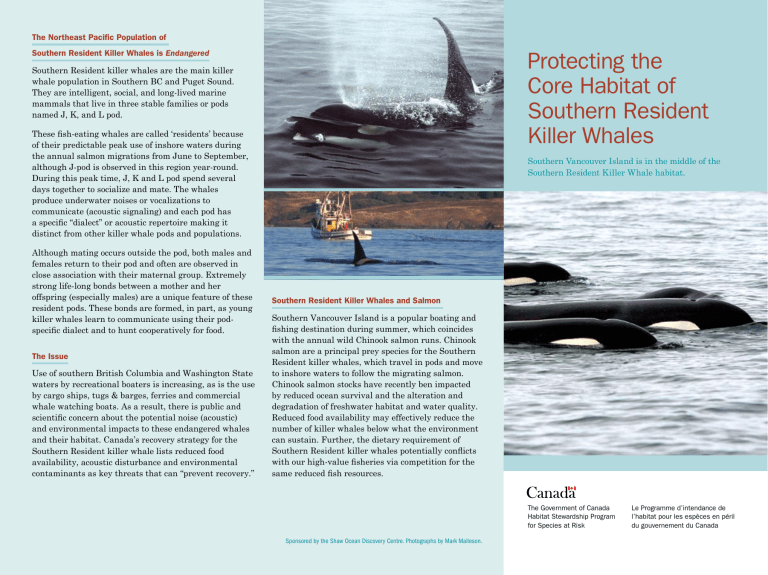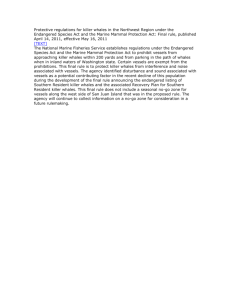Protecting the Core Habitat of Southern Resident Killer Whales

The Northeast Pacific Population of
Southern Resident Killer Whales is Endangered
Southern Resident killer whales are the main killer whale population in Southern BC and Puget Sound.
They are intelligent, social, and long-lived marine mammals that live in three stable families or pods named J, K, and L pod.
These fish-eating whales are called ‘residents’ because of their predictable peak use of inshore waters during the annual salmon migrations from June to September, although J-pod is observed in this region year-round.
During this peak time, J, K and L pod spend several days together to socialize and mate. The whales produce underwater noises or vocalizations to communicate (acoustic signaling) and each pod has a specific “dialect” or acoustic repertoire making it distinct from other killer whale pods and populations.
Although mating occurs outside the pod, both males and females return to their pod and often are observed in close association with their maternal group. Extremely strong life-long bonds between a mother and her offspring (especially males) are a unique feature of these resident pods. These bonds are formed, in part, as young killer whales learn to communicate using their podspecific dialect and to hunt cooperatively for food.
The Issue
Use of southern British Columbia and Washington State waters by recreational boaters is increasing, as is the use by cargo ships, tugs & barges, ferries and commercial whale watching boats. As a result, there is public and scientific concern about the potential noise (acoustic) and environmental impacts to these endangered whales and their habitat. Canada’s recovery strategy for the
Southern Resident killer whale lists reduced food availability, acoustic disturbance and environmental contaminants as key threats that can “prevent recovery.”
Southern Resident Killer Whales and Salmon
Southern Vancouver Island is a popular boating and fishing destination during summer, which coincides with the annual wild Chinook salmon runs. Chinook salmon are a principal prey species for the Southern
Resident killer whales, which travel in pods and move to inshore waters to follow the migrating salmon.
Chinook salmon stocks have recently ben impacted by reduced ocean survival and the alteration and degradation of freshwater habitat and water quality.
Reduced food availability may effectively reduce the number of killer whales below what the environment can sustain. Further, the dietary requirement of
Southern Resident killer whales potentially conflicts with our high-value fisheries via competition for the same reduced fish resources.
Protecting the
Core Habitat of
Southern Resident
Killer Whales
Southern Vancouver Island is in the middle of the
Southern Resident Killer Whale habitat.
The Government of Canada
Habitat Stewardship Program for Species at Risk
Le Programme d’intendance de l’habitat pour les espèces en péril du gouvernement du Canada
Sponsored by the Shaw Ocean Discovery Centre. Photographs by Mark Malleson.
The Efficiency of Water as a Carrier of Sound
Hearing is among the primary senses in cetaceans
(whales, dolphins and porpoises) and is similar in importance as seeing is to us. As a result, whales have evolved extremely sensitive hearing and depend on sound to find food, to communicate, and to navigate the ocean’s complex landscape. The acoustic ocean environment is being dramatically transformed by human activity. The leading contributors to ocean noise issues are military activities, high-energy seismic surveys, and year-round, low-frequency engine noise from commercial shipping, which travel great distances.
At the community level, studies have looked at the effects of commercial whale watching on killer whales in British Columbia and Washington State, but the current results are inconclusive. Even so, each additional boat engine in the Southern Residents’ habitat may further decrease the quality of the coastal ecosystem upon which their survival depends.
Killer Whale Habitat and Pollution
BC killer whales are considered among the most contaminated marine mammals in the world, mainly due to industrial contaminants (PCBs and PBDE fireretardants) that accumulate in their bodies from the
“contaminated” food they eat. The Southern Residents are more contaminated than the Northern Resident fish-eating population likely due to their presence in the more industrialized southern waters. Studies indicate that these contaminants are a risk to the health and viability of the Southern Residents. As responsible stewards, we must do our part to minimize or prevent the release of additional toxins to the killer whales’ ocean habitat that will affect the health of their food source and have an additive negative effect on the whales’ already impaired health. From household and garden/ lawn chemical products to boat engine oil and fuel, you can make wise choices in using biodegradable, non-toxic products and in carefully handling and disposing of unavoidable toxic products.
Our Goal
Our goal is to improve habitat quality for these remarkable animals through a decreased input of engine oil and additives to the marine environment, and extremely courteous and responsible boating in the vicinity of whales to effectively create “moving sanctuaries” through education. The above measures will provide tangible benefits to the whales, including surface waters with less toxic engine oil and additives, and quieter areas for foraging and socializing.
Whale Watching
Viewing Southern Resident killer whales can be a thrilling experience and is a precious public resource to be protected. Responsible whale watching is relatively benign, and commercial whale watching tours can greatly contribute to the quality of public education on the status of Southern Resident killer whales. We strongly urge all boaters to follow the Be Whale Wise guidelines (www.bewhalewise.org). Always keep a lookout for whales, and slow down (less than 7 knots) if you are near a commercial whale watch vessel that is stopped. Reduce speed, or stop if you see a whale. There will likely be other whales in the vicinity below the surface, out of sight. Let’s set an example for others.


